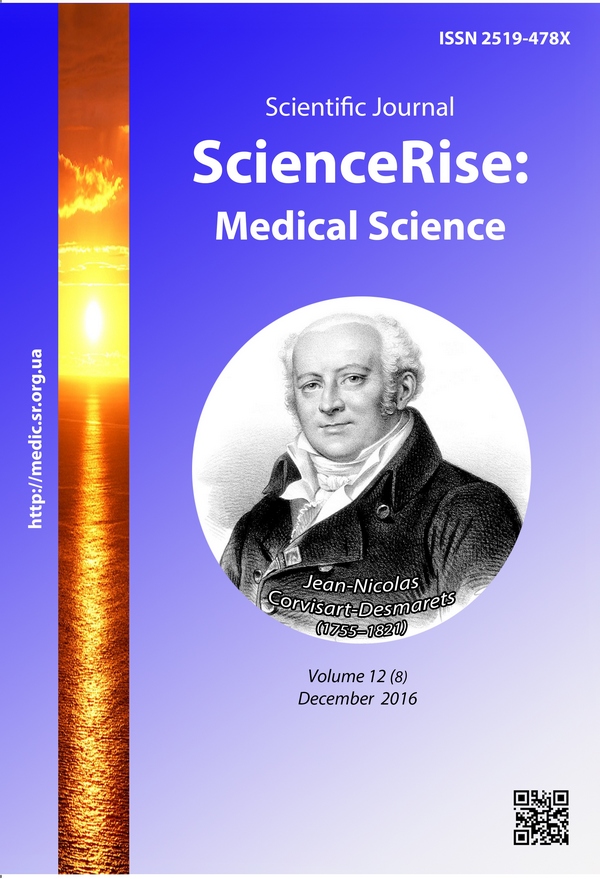The analysis of self-attitude in cosmetological patients with low self-esteem
DOI:
https://doi.org/10.15587/2519-4798.2016.86429Keywords:
self-esteem, self-attitude, cosmetological patients, appearance, medical-psychological help, psychodermatology, cosmetological medicineAbstract
The features of self-attitude in cosmetological patients were studied in the research.
Contingent and methods of research. The study was carried out on the base of medical center “CA-CLINIC” (city Kiev) during 2014 – 2016 years. Testing included 204 women, who addressed for cosmetological help. The interrogated persons were divided in groups depending on the level of self-esteem: the main group included persons with low self-esteem (MG, n=108) and group of comparison – women with normal self-esteem (CG, n=96). Psychodiagnostic instrument is the questionnaire of self-attitude by V.V. Stolin and S.R. Pantileev.
Results. It was revealed, that women with low self-esteem had lower levels of global self-attitude, self-respect, autosympathy, self-interest, expected attitude of others, self-confidence, readiness to self-perception, self-understanding, self-management and the highest one – self-accusation as opposite to the interrogated with normal self-esteem. The women with low self-esteem in their self-attitude expressed the negative setting as to the own Me, incertitude in own physical and psychological qualities, did not understood their negative features or overstated their value, were inclined to self-accusation and expressed the acute desire to change themselves. Self-attitude in women with low self-esteem was disharmonic and characterized with high level of self-rejection, decrease of self-respect and self-understanding, alienation of subjectively negative features, exaggeration of own defects.
Conclusions. Cosmetological patients with low self-esteem form the separate category of clients and need the use of medical-psychological arrangements, directed on harmonization of disharmonic self-attitude
References
- Conrado, L. A., Hounie, A. G., Diniz, J. B., Fossaluza, V., Torres, A. R., Miguel, E. C., Rivitti, E. A. (2010). Body dysmorphic disorder among dermatologic patients: Prevalence and clinical features. Journal of the American Academy of Dermatology, 63 (2), 235–243. doi: 10.1016/j.jaad.2009.09.017
- Petrova, N. N., Gribova, O. M. (2014). Dysmorphophobia in clinic of aesthetic surgery. Mental disorders in general medicine, 1, 26–30.
- Moroz, S. M., Yavorskaya, I. (2015). Dysmorphophobia and Dismorphomania: mirrors cheating. Cosmetologist, 6 (74), 108–110.
- Sharma, P., Sreejayan, K., Ghosh, S., Behere, R. (2013). Psychiatric evaluation in dermatology: An overview. Indian Journal of Dermatology, 58 (1), 39. doi: 10.4103/0019-5154.105286
- Filakovic, P., Petek, A., Koic, O., Radanovic-Grguric, L., Degmecic, D. (2009). Comorbidity of depressive and dermatologic disorders – therapeutic aspects. Psychiatria Danubina, 21 (3), 401–410.
- Bewley, A., Affleck, A., Bundy, C., Higgins, E., McBride, S. (2013). Psychodermatology services guidance: the report of the British Associationof Dermatologists' Psychodermatology Working Party. British Journal of Dermatology, 168 (6), 1149–1150. doi: 10.1111/bjd.12330
- Aleksandrov, A. A., Bagnenko, E. S. (2012). Psychological characteristics of women with cosmetic defects of the facial skin. Herald of psychotherapy, 41 (46), 52–66.
- Bodnar, L. A. (2011). Clinical-psychopathological and pathopsychological characteristics of patients who turned to plastic surgeons for rhinoplasty. Mental Health, 1-2 (30-31), 4–7.
- Sats, E. A., Slobodchikov, I. M. (2015). Features self-awareness for women – clients beauty salon. Modern Problems of Science and Education, 1. Available at: http://www.science-education.ru/ru/article/view?id=18589 doi: 10.17513/spno.121-18589
- Thompson, A. R. (2013). Body Image in dermatology. Mental disorders in general medicine, 2, 36–39.
- Tkhostov, A. Sh., Vinogradova, M. G., Ermusheva, A. A., Romanov, D. V. (2014). Psychological aspects of pathological bodily sensations in psychiatric disorders, realized in the area of the skin. Mental disorders in general medicine, 1, 14–25.
Downloads
Published
How to Cite
Issue
Section
License
Copyright (c) 2016 Михайло Анатолійович Юдін

This work is licensed under a Creative Commons Attribution 4.0 International License.
Our journal abides by the Creative Commons CC BY copyright rights and permissions for open access journals.
Authors, who are published in this journal, agree to the following conditions:
1. The authors reserve the right to authorship of the work and pass the first publication right of this work to the journal under the terms of a Creative Commons CC BY, which allows others to freely distribute the published research with the obligatory reference to the authors of the original work and the first publication of the work in this journal.
2. The authors have the right to conclude separate supplement agreements that relate to non-exclusive work distribution in the form in which it has been published by the journal (for example, to upload the work to the online storage of the journal or publish it as part of a monograph), provided that the reference to the first publication of the work in this journal is included.









